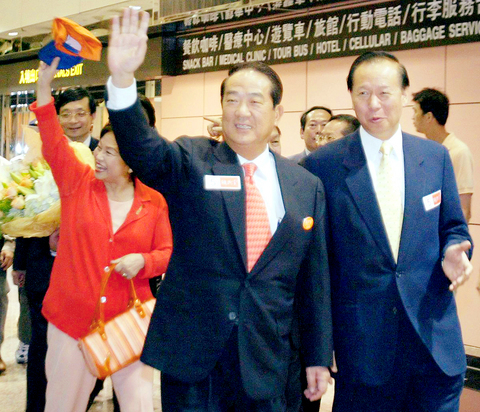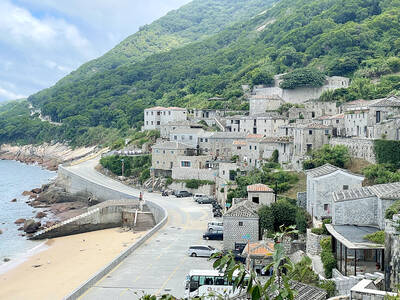People First Party (PFP) Chairman James Soong (宋楚瑜) said yesterday that he is willing to meet with President Chen Shui-bian (陳水扁) regarding the six-point communique he drew up with Chinese President Hu Jintao (胡錦濤) on Thursday, and said the communique was a breakthrough. China had committed on paper their acknowledgement of the so-called "1992 consensus" and promised not to take military action should Taiwan abstain from making any moves toward independence, he said.
"If President Chen sees the text and publicized results of our [Hu and Soong] meeting and if he feels he needs to better understand it, I am willing to meet with him. If he wishes to meet, and he sees clearly [the situation] and is willing to push through [the meaning of the communique], then I am very willing to see him," said Soong yesterday.
Soong yesterday returned from a nine-day tour of China, during which he visited four Chinese cities and met with Hu in his capacity as Chinese Communist Party (CCP) chairman. During the meeting, the second between a Taiwanese opposition leader and Hu this month, Soong and Hu drew up a six-point communique which reiterated their parties' united stance on their opposition to Taiwanese independence, support for the so-called "1992 consensus," and China's willingness to push through various economic proposals, including a cross-strait free trade agreement.

PHOTO: YAO CHIEH-HUI, TAIPEI TIMES
Speaking to the media at the airport upon his return to the nation at 3:30pm and at press conference later yesterday, Soong gave a further explanation of his six-point agreement with Hu and welcomed the news yesterday from China's Taiwan Affairs Office (TAO) that China had decided to offer various policy "gifts" to Taiwan.
At the PFP press conference yesterday, Soong clarified that the new term, "two sides of the Strait, one China," was a new way of considering the "1992 consensus," and was not meant to take the place of the often-referred to concept behind the consensus: the "one China principle, with different interpretations."
The new phrase, "two sides of the Strait, one China" recognizes the reality of the cross-strait situation, given the historical conflict between the governments of China and the Republic of China, Soong said.
"It is important to restore the historical truth of the cross-strait situation. As a result, the phrase `two sides of the Strait, one China,' acknowledges the equal relationship between [China and Taiwan]," Soong said.
A further breakthrough, according to Soong, is having China commit to paper the specific origins of the "1992 consensus."
The so-called "1992 consensus" refers to an so-called agreement between Taiwanese and Chinese negotiators during a 1992 meeting in Hong Kong to base any future negotiations on the "one China" principle, but what is meant by "one China" can be interpreted differently.
While the pan-blue camp said the consensus should serve as the basis of a new round of talks between Taiwan and China, the current administration has stated on many occasions that it does not acknowledge the consensus and that it does not exist.
Because Soong-Hu the communique characterizes the current cross-strait situation as "two sides of the strait, one China," Soong suggested the Chen administration choose to accept the terminology and interpret the "1992 consensus" in this way.

The first two F-16V Bock 70 jets purchased from the US are expected to arrive in Taiwan around Double Ten National Day, which is on Oct. 10, a military source said yesterday. Of the 66 F-16V Block 70 jets purchased from the US, the first completed production in March, the source said, adding that since then three jets have been produced per month. Although there were reports of engine defects, the issue has been resolved, they said. After the jets arrive in Taiwan, they must first pass testing by the air force before they would officially become Taiwan’s property, they said. The air force

GLOBAL: Although Matsu has limited capacity for large numbers of domestic tourists, it would be a great high-end destination for international travelers, an official said Lienchiang County’s (Matsu) unique landscape and Cold War history give it great potential to be marketed as a destination for international travelers, Tourism Administration Director General Chen Yu-hsiu (陳玉秀) said at the weekend. Tourism officials traveled to the outlying island for the Matsu Biennial, an art festival that started on Friday to celebrate Matsu’s culture, history and landscape. Travelers to Matsu, which lies about 190km northwest of Taipei, must fly or take the state-run New Taima passenger ship. However, flights are often canceled during fog season from April to June. Chen spoke about her vision to promote Matsu as a tourist attraction in

PAWSITIVE IMPACT: A shop owner said that while he adopted cats to take care of rodents, they have also attracted younger visitors who also buy his dried goods In Taipei’s Dadaocheng (大稻埕), cats lounging in shops along Dihua Street do more than nap amid the scent of dried seafood. Many have become beloved fixtures who double as photography models, attracting visitors and helping boost sales in one of the capital’s most historic quarters. A recent photo contest featuring more than a dozen shop cats drew more than 2,200 submissions, turning everyday cat-spotting into a friendly competition that attracted amateur and professional photographers. “It’s rare to see cats standing, so when it suddenly did, it felt like a lucky cat,” said Sabrina Hsu (徐淳蔚), who won the NT$10,000 top prize in

STRIKE: Some travel agencies in Taiwan said that they were aware of the situation in South Korea, and that group tours to the country were proceeding as planned A planned strike by airport personnel in South Korea has not affected group tours to the country from Taiwan, travel agencies said yesterday. They added that they were closely monitoring the situation. Personnel at 15 airports, including Seoul’s Incheon and Gimpo airports, are to go on strike. They announced at a news conference on Tuesday that the strike would begin on Friday next week and continue until the Mid-Autumn Festival next month. Some travel agencies in Taiwan, including Cola Tour, Lion Travel, SET Tour and ezTravel, said that they were aware of the situation in South Korea, and that group